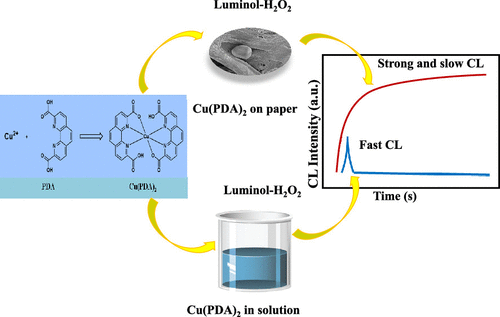当前位置:
X-MOL 学术
›
ACS Appl. Mater. Interfaces
›
论文详情
Our official English website, www.x-mol.net, welcomes your
feedback! (Note: you will need to create a separate account there.)
Long-Lasting Luminol Chemiluminescence Emission with 1,10-Phenanthroline-2,9-dicarboxylic Acid Copper(II) Complex on Paper
ACS Applied Materials & Interfaces ( IF 8.3 ) Pub Date : 2021-11-02 , DOI: 10.1021/acsami.1c14563 Congcong Lv 1 , Xiaoyan Guo 1 , Yue Hou 1 , Wei Liu 1 , Yanli Guo 1 , Zixuan Zhang 1 , Yan Jin 1 , Baoxin Li 1
ACS Applied Materials & Interfaces ( IF 8.3 ) Pub Date : 2021-11-02 , DOI: 10.1021/acsami.1c14563 Congcong Lv 1 , Xiaoyan Guo 1 , Yue Hou 1 , Wei Liu 1 , Yanli Guo 1 , Zixuan Zhang 1 , Yan Jin 1 , Baoxin Li 1
Affiliation

|
As most of the known systems are flashtype, long-lasting chemiluminescence (CL) emissions are extremely needed for the application of cold light sources, accurate CL quantitative analysis, and biological mapping. In this work, the flashtype system of luminol was altered to a long lasting CL system just because of the paper substrate. The Cu(II)-based organic complex was loaded on the paper surface, which can trigger luminol-H2O2 to produce a long lasting CL emission for over 30 min. By using 1,10-phenanthroline-2,9-dicarboxylic acid (PDA) as the ligand, a hexacoordinated Cu(II)-based organic complex was synthesized by the simple freeze-drying method. It is interesting that the complex morphology can be controlled by adding different amounts of water in the synthesizing procedure. The complex with a certain size can be definitely trapped in the pores of the cellulose. Then, slow diffusion, which can be attributed to the long lasting CL emission, was produced. With the high catalytic activity of the complex, reactive oxygen species from H2O2 was generated and was responsible for the high CL intensity. By using the paper substrate, the flash-type luminol system can be easily transferred to the long-duration CL system without any extra reagent. This long-lasting emission system was used for hydrogen sulfide detection by the CL imaging method. This paper-based sensor has great potential for CL imaging in the clinical field in the future.
中文翻译:

纸上具有 1,10-菲咯啉-2,9-二羧酸铜 (II) 配合物的持久鲁米诺化学发光发射
由于大多数已知系统都是闪光型的,因此冷光源的应用、准确的 CL 定量分析和生物绘图非常需要持久的化学发光 (CL) 发射。在这项工作中,鲁米诺的闪光型系统仅仅因为纸基材而被改变为持久的 CL 系统。将Cu(II)基有机配合物负载在纸表面,可引发鲁米诺-H 2 O 2产生超过 30 分钟的持久 CL 发射。以1,10-菲咯啉-2,9-二羧酸(PDA)为配体,通过简单的冷冻干燥法合成了六配位Cu(II)基有机配合物。有趣的是,复杂的形态可以通过在合成过程中加入不同量的水来控制。一定大小的复合物肯定能被困在纤维素的孔隙中。然后,产生了缓慢扩散,这可归因于持久的 CL 发射。由于复合物的高催化活性,来自 H 2 O 2 的活性氧产生并负责高 CL 强度。通过使用纸基材,闪光型鲁米诺系统可以很容易地转移到长效 CL 系统,而无需任何额外的试剂。这种长效发射系统用于通过 CL 成像方法检测硫化氢。这种基于纸张的传感器在未来临床领域的 CL 成像方面具有巨大的潜力。
更新日期:2021-11-17
中文翻译:

纸上具有 1,10-菲咯啉-2,9-二羧酸铜 (II) 配合物的持久鲁米诺化学发光发射
由于大多数已知系统都是闪光型的,因此冷光源的应用、准确的 CL 定量分析和生物绘图非常需要持久的化学发光 (CL) 发射。在这项工作中,鲁米诺的闪光型系统仅仅因为纸基材而被改变为持久的 CL 系统。将Cu(II)基有机配合物负载在纸表面,可引发鲁米诺-H 2 O 2产生超过 30 分钟的持久 CL 发射。以1,10-菲咯啉-2,9-二羧酸(PDA)为配体,通过简单的冷冻干燥法合成了六配位Cu(II)基有机配合物。有趣的是,复杂的形态可以通过在合成过程中加入不同量的水来控制。一定大小的复合物肯定能被困在纤维素的孔隙中。然后,产生了缓慢扩散,这可归因于持久的 CL 发射。由于复合物的高催化活性,来自 H 2 O 2 的活性氧产生并负责高 CL 强度。通过使用纸基材,闪光型鲁米诺系统可以很容易地转移到长效 CL 系统,而无需任何额外的试剂。这种长效发射系统用于通过 CL 成像方法检测硫化氢。这种基于纸张的传感器在未来临床领域的 CL 成像方面具有巨大的潜力。


















































 京公网安备 11010802027423号
京公网安备 11010802027423号